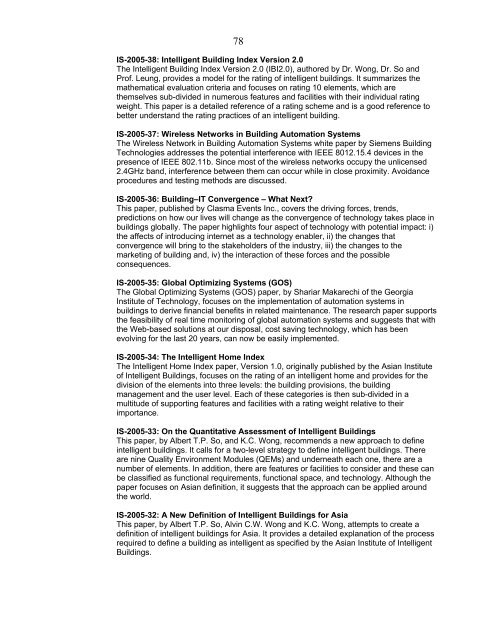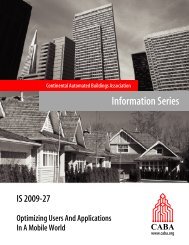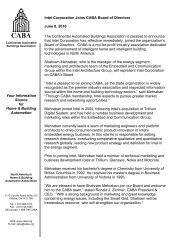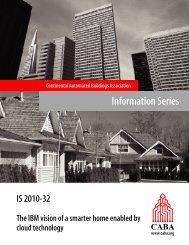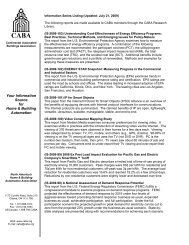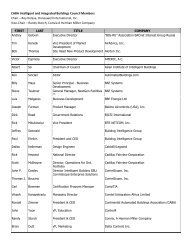Your Information Source for Home & Building Automation
Your Information Source for Home & Building Automation
Your Information Source for Home & Building Automation
You also want an ePaper? Increase the reach of your titles
YUMPU automatically turns print PDFs into web optimized ePapers that Google loves.
78<br />
IS-2005-38: Intelligent <strong>Building</strong> Index Version 2.0<br />
The Intelligent <strong>Building</strong> Index Version 2.0 (IBI2.0), authored by Dr. Wong, Dr. So and<br />
Prof. Leung, provides a model <strong>for</strong> the rating of intelligent buildings. It summarizes the<br />
mathematical evaluation criteria and focuses on rating 10 elements, which are<br />
themselves sub-divided in numerous features and facilities with their individual rating<br />
weight. This paper is a detailed reference of a rating scheme and is a good reference to<br />
better understand the rating practices of an intelligent building.<br />
IS-2005-37: Wireless Networks in <strong>Building</strong> <strong>Automation</strong> Systems<br />
The Wireless Network in <strong>Building</strong> <strong>Automation</strong> Systems white paper by Siemens <strong>Building</strong><br />
Technologies addresses the potential interference with IEEE 8012.15.4 devices in the<br />
presence of IEEE 802.11b. Since most of the wireless networks occupy the unlicensed<br />
2.4GHz band, interference between them can occur while in close proximity. Avoidance<br />
procedures and testing methods are discussed.<br />
IS-2005-36: <strong>Building</strong>–IT Convergence – What Next<br />
This paper, published by Clasma Events Inc., covers the driving <strong>for</strong>ces, trends,<br />
predictions on how our lives will change as the convergence of technology takes place in<br />
buildings globally. The paper highlights four aspect of technology with potential impact: i)<br />
the affects of introducing internet as a technology enabler, ii) the changes that<br />
convergence will bring to the stakeholders of the industry, iii) the changes to the<br />
marketing of building and, iv) the interaction of these <strong>for</strong>ces and the possible<br />
consequences.<br />
IS-2005-35: Global Optimizing Systems (GOS)<br />
The Global Optimizing Systems (GOS) paper, by Shariar Makarechi of the Georgia<br />
Institute of Technology, focuses on the implementation of automation systems in<br />
buildings to derive financial benefits in related maintenance. The research paper supports<br />
the feasibility of real time monitoring of global automation systems and suggests that with<br />
the Web-based solutions at our disposal, cost saving technology, which has been<br />
evolving <strong>for</strong> the last 20 years, can now be easily implemented.<br />
IS-2005-34: The Intelligent <strong>Home</strong> Index<br />
The Intelligent <strong>Home</strong> Index paper, Version 1.0, originally published by the Asian Institute<br />
of Intelligent <strong>Building</strong>s, focuses on the rating of an intelligent home and provides <strong>for</strong> the<br />
division of the elements into three levels: the building provisions, the building<br />
management and the user level. Each of these categories is then sub-divided in a<br />
multitude of supporting features and facilities with a rating weight relative to their<br />
importance.<br />
IS-2005-33: On the Quantitative Assessment of Intelligent <strong>Building</strong>s<br />
This paper, by Albert T.P. So, and K.C. Wong, recommends a new approach to define<br />
intelligent buildings. It calls <strong>for</strong> a two-level strategy to define intelligent buildings. There<br />
are nine Quality Environment Modules (QEMs) and underneath each one, there are a<br />
number of elements. In addition, there are features or facilities to consider and these can<br />
be classified as functional requirements, functional space, and technology. Although the<br />
paper focuses on Asian definition, it suggests that the approach can be applied around<br />
the world.<br />
IS-2005-32: A New Definition of Intelligent <strong>Building</strong>s <strong>for</strong> Asia<br />
This paper, by Albert T.P. So, Alvin C.W. Wong and K.C. Wong, attempts to create a<br />
definition of intelligent buildings <strong>for</strong> Asia. It provides a detailed explanation of the process<br />
required to define a building as intelligent as specified by the Asian Institute of Intelligent<br />
<strong>Building</strong>s.


